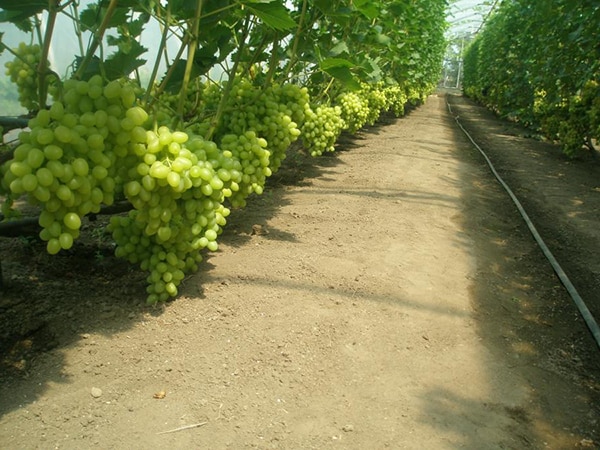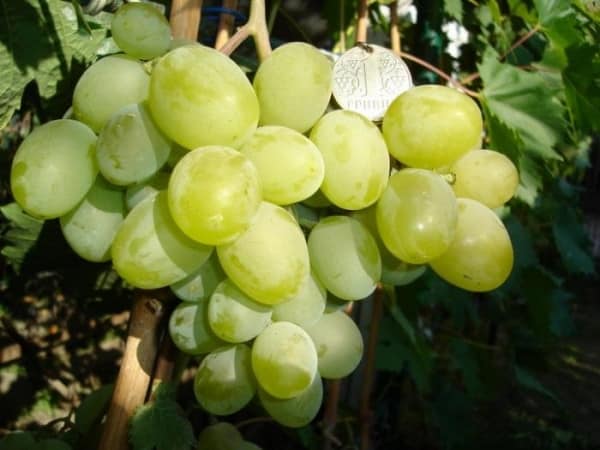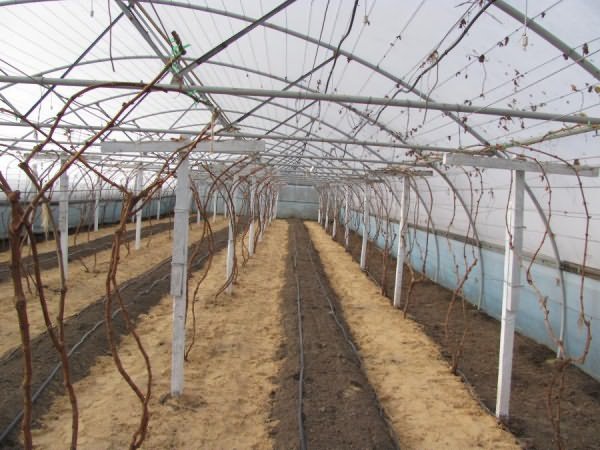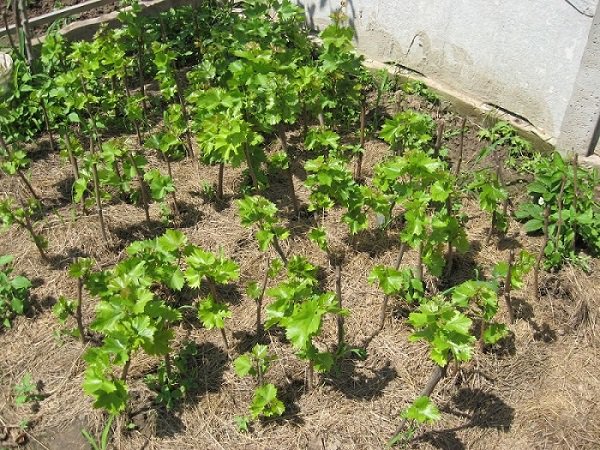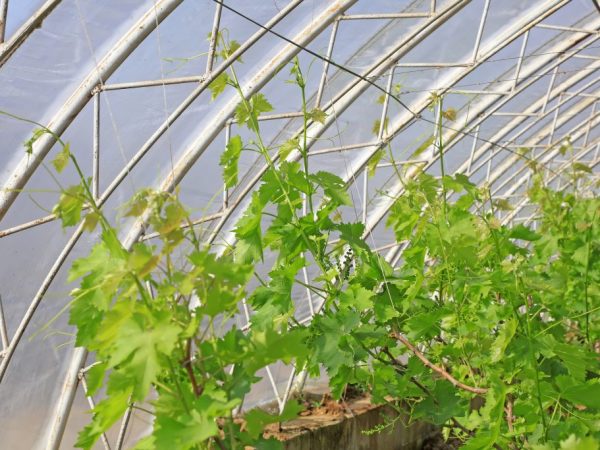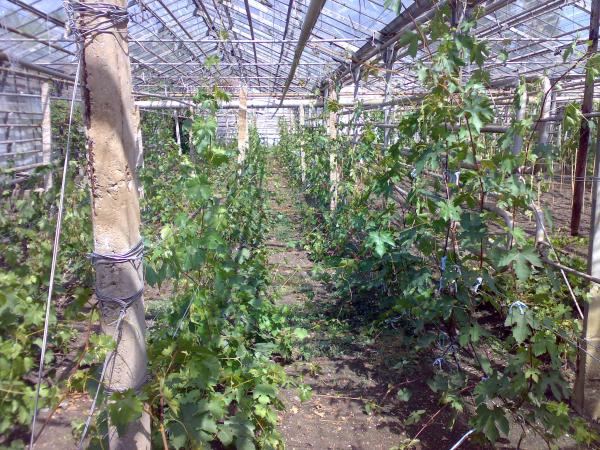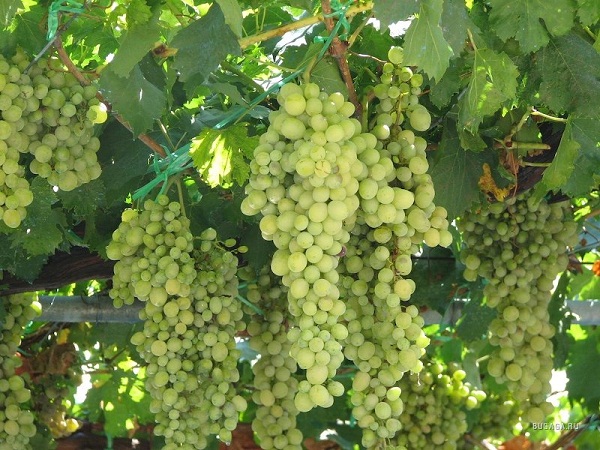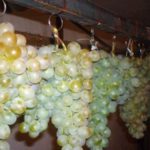When growing grapes in a greenhouse, the opportunity to harvest a large and high-quality harvest increases. The culture loves a lot of warmth and sunlight, but the climate of the region does not always meet these requirements. Indoors it is easier to recreate optimal conditions for grape development. It is important to choose the right variety, follow agricultural practices and some other requirements.
Advantages of growing grapes in a greenhouse
Growing grapes in a greenhouse, compared to open-air beds, has a number of positive aspects.
This planting method is especially suitable for areas with an unstable climate:
- It is easier to maintain a given temperature and humidity level indoors. Even without an artificial heater, the room will be 3-4 degrees warmer than outside.
- If all the rules of cultivation and care are followed, the harvest can be harvested 3-4 weeks earlier.
- Convenient to care for in any season, easier to harvest.
- Infectious diseases develop less frequently, so there is no need to treat the bushes with chemicals.
- There is no risk that the mature crop will be damaged by wasps and other insects.
- The design of the greenhouse protects the plant from spring frosts, low temperatures in winter, hail and heavy rains.
- The number of bunches increases significantly.
In the interval between the seedlings in the greenhouse, you can plant flowers, vegetables, and herbs.
Variety selection
An important step is choosing the appropriate variety for planting in the greenhouse. It is important that the selected grape variety is characterized by bisexual flowers. Experienced gardeners recommend choosing grape varieties that have early ripening boundaries.
For growing in a greenhouse, it is recommended to choose varieties with thin tassels. Dense, thick branches will transmit light poorly and increase the risk of developing fungal diseases:
- Michurinsky table grapes are a variety with early ripening boundaries. It is characterized by strong growth and numerous harvests. The clusters are formed in a conical shape, weighing up to 400 g. Oval-shaped berries of a dark burgundy color weigh 4 g. Disease resistance is average.
- Table view Laura grapes characterized by very early harvest ripening. The clusters are formed in a large size, conical in shape. The weight of one bunch reaches 1 kg.The berries have an oblong shape, light green color, weigh 7-9 g. They rarely get sick, tolerate cold well, and the berries are not prone to cracking.
- The Korinka Russian variety is distinguished by its strong growth, high yield, early harvest ripening, and resistance to frost and disease. The bunches are not very large. The berries are small, weigh 2-3 g. The skin is thin, but strong, yellow-green in color. There are no seeds inside.
- Arcadia grapes are a table variety with early ripening. The clusters are large, cylindrical in shape, weigh up to 700 g. The berries are also large, weighing up to 15 g, the skin color is green-white.
Other popular varieties for indoor ground include: Moskovsky Sustainable, Ruslan, Druzhba, Timur, Moldova, Vostorg, Irinka.
Greenhouse requirements
A greenhouse designed for planting and growing grapes has its own distinctive features:
- The height of the greenhouse must be more than 2 meters. The dimensions will depend on the dimensions of the trellises for tying. It is better to choose an arched design.
- To prevent weeds, pests, and drafts from spreading in the greenhouse, it is better to make a small layer of concrete foundation.
- In order to retain heat and allow light to penetrate well without obstacles, you need to make the cladding from high-quality material. Transparent cellular polycarbonate is best suited. A distinctive feature is year-round use. Film cover is also used.
- Many grape varieties immediately after planting begin to bear fruit after 5 years. Therefore, the frame of the greenhouse must be made of durable material that will last for many years.
- It is better to provide the greenhouse with artificial heating. For this purpose, infrared lamps are hung, and conventional heating devices are also suitable.
- It is also recommended to install lamps to create artificial lighting.
- The room must be regularly ventilated. For a small greenhouse, it is enough to make two opening windows.
If all these conditions are met, the culture will develop well and problems will not arise.
Features of greenhouse preparation
Before you start planting grape seedlings in a greenhouse at your dacha, it is necessary to carry out preparatory work.
The soil must first be prepared. Grapes love light, fertile soil with good aeration. The substrate is prepared from sand, peat, limestone, loam and fertile soil. It is recommended to add mineral components. The resulting soil mixture is poured into each hole intended for planting. If there are a lot of seedlings, then instead of separate holes, dig a trench of the required depth and width.
To protect the grapevine from burns in hot weather, a wire is stretched horizontally at a distance of 45 cm from the walls and ceiling of the greenhouse. The wire will limit the extension of the branches, and they will not touch the hot partitions of the structure.
Landing Features
Planting of seedlings in a greenhouse begins in November or early spring. Seedlings must be healthy, without damage, signs of freezing and have strong roots.
It is important to know how to plant grapes indoors. Recesses for planting shrubs are made at a distance of 48 cm from the wall of the greenhouse. The interval between the seedlings themselves should be at least 1.5 cm. The scheme that is recommended to be followed when planting grapes in a polycarbonate greenhouse:
- the depth of the pit is 68 cm, the width is 80 cm, at the same stage a support for tying is installed;
- a layer of wood ash is placed at the bottom;
- be sure to fill the drainage layer;
- install a tube that is useful for watering;
- then they fill in a layer of fertile soil and water it;
- Seedlings are planted and covered with soil.
Growing grapes in a greenhouse or hothouse is not difficult if you follow all the basic rules.
Care
The question of how to care for grapes especially often arises among novice gardeners. Care involves maintaining the desired level of temperature, humidity and lighting. The air temperature in the greenhouse depends on the stage of vegetative development of the crop:
- In the spring, when buds begin to form, the optimal numbers on the thermometer are considered to be +15 degrees, at night - not lower than +8 degrees.
- During the flowering period, the temperature should be even higher - up to +25 degrees, at night - not lower than +15 degrees.
- A hot climate is necessary during the ripening period of berries. During this period, the temperature should be raised to +30 degrees, and at night +20 degrees.
In addition to these rules, care involves establishing a schedule for watering, fertilizing, loosening and weeding the soil, as well as carrying out the procedure for pruning branches.
Bees should be attracted indoors for pollination. If this is not successful, then you can carry out the procedure yourself. To do this, once a day (preferably before lunch) you should carefully shake the grape branches.
Grapes grown in a greenhouse are rarely attacked by insect pests or infected with infectious diseases. But experienced gardeners still recommend preventive treatment. Common diseases affecting the crop include: mildew, anthracnose, oidium, gray rot. Pests dangerous to grapes are grape mite, leaf rollers, aphids.
If the greenhouse is not equipped with a heating system, then in mid-October the grape bushes should be hidden from the oncoming cold weather.The branches are tilted to the ground and covered with, for example, roofing felt, a warm blanket, sawdust or spruce branches.
Pruning
The formation of the bush should be carried out annually. The procedure allows you to leave the healthiest and most fruit-bearing shoots. In addition, the likelihood of contracting infections is reduced. Light and heat are distributed evenly to all parts of the plant.
Some time after landing, the first grape pruning. Remove dry, damaged branches that take away excess strength and nutrients. Weak and unnecessary branches need to be cut off regularly.
The classic grape pruning scheme looks like this:
- Initially, the strongest shoot is determined, which will serve as the central stem;
- the selected strong stem is cut off, leaving two or three eyes;
- in the next season, two new shoots appear from the remaining buds, one of them is cut short (by 2-3 buds), and the other long (by 8-9 buds);
- It is advisable to start pruning from the bottom.
A similar procedure is repeated annually. Non-main side branches should be pruned to the first leaf, barren shoots to the fifth leaf. This will leave more space for the development of fertile shoots.
Top dressing
The addition of additional nutritional components ensures healthy growth and development of grapes. Increases resistance to diseases and pest invasions.
Grape feeding is carried out in four stages:
- in the spring when planting (potassium, phosphorus and nitrogen components are added);
- two weeks before the start of flowering (it is better to use organic and mineral compounds; a composition, for example, of rotted manure, potassium sulfate and superphosphate is suitable);
- at the initial stage of berry formation (the amount of potassium and phosphorus in the compositions is increased);
- Fertilizers are necessary during the period of active ripening of bunches.
Fertilizer is applied into specially dug grooves near each trunk. Superphosphate and compositions based on potassium and phosphorus elements are suitable as fertilizing. You should be careful when using nitrogen fertilizers.
During the period of bud formation and blossoming, it is recommended to add ammonium nitrate. It promotes rapid and good development of green mass and buds. Before flowering, it is useful to add superphosphate.
Watering
The grapes do not need frequent watering. Excessive soil moisture causes the roots to rot and the berries to crack. Water should not be poured at the very root of the bush. Be sure to make grooves or pour water into the tubes that were inserted at the pit preparation stage.
The first watering is carried out before planting the seedling. For each hole dug, 20 liters of warm, settled water are calculated. After a week, watering is repeated. To prevent moisture from evaporating, it is advisable to mulch the soil. Peat, sawdust, and moss are suitable as mulch.
During the ripening period of grape bunches, watering is reduced. If this condition is not taken into account, the berries will rot and crack. In hot summers you need to water once a week.
Prepare water for irrigation in advance. It should be warm and settled. It is best to carry out the watering procedure early in the morning. It is not recommended to water in the evening, as humid air at night negatively affects the development of the crop.

